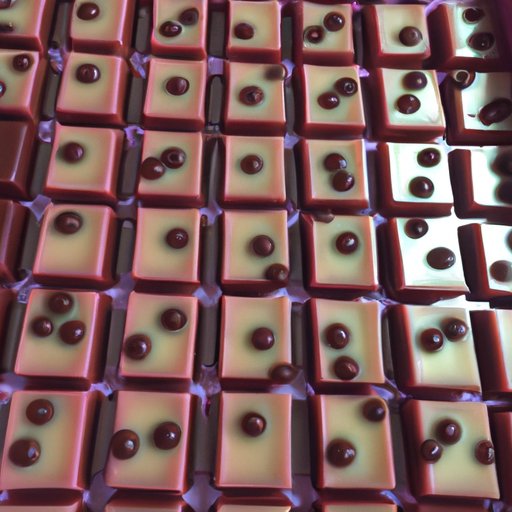Introduction
Have you ever opened a bar of chocolate, only to find a white, powdery coating on top? This common problem is called chocolate blooming, and it often strikes fear in the hearts of chocoholics everywhere. But fear not! Understanding the root cause of this issue is key to preventing it and still enjoying your favorite treats. In this article, we will explore why chocolate turns white, the science behind it, and how to prevent and fix it.
The Science Behind Chocolate’s White Coating: Understanding Fat Bloom
Chocolate blooming is caused by a phenomenon called fat bloom. Fat bloom occurs when the cocoa butter in chocolate separates from the other ingredients and rises to the surface, creating a white coating. This can happen to any type of chocolate, but it is most noticeable on chocolate that has a higher percentage of cocoa butter.
The scientific explanation for fat bloom is that chocolate contains different types of fat crystals that can form during the manufacturing process. When these crystals are not stable, they can change shapes and migrate to the surface of the chocolate, causing the white residue.
Not only is the white coating unappetizing, but it also affects the quality and taste of the chocolate. Fat bloom changes the texture of the chocolate, making it chalky and less smooth. It can also alter the flavor, making it stale or rancid.
One example of this is when you leave a chocolate bar in a warm car and then try to eat it. The heat can trigger the fat to rise to the surface and create that unappetizing white coating.
Why Does Your Favorite Chocolate Sometimes Look Like It’s Gone Bad?
If you’re unfamiliar with fat bloom, you may mistake it for mold, causing you to throw away perfectly good chocolate. The difference between the two is easy to distinguish. Mold is fuzzy and has a blue or green color. Fat bloom appears as a white or gray coating and has a powdery texture.
In most cases, chocolate that has bloomed is still perfectly safe to eat. However, if the chocolate has been exposed to moisture or smells rancid, it’s best to discard it.
Exploring the Factors That Cause Chocolate to Turn White
Now that we know what fat bloom is and how it looks, let’s explore the different factors that can cause it.
One major factor is temperature fluctuation. When chocolate is exposed to high temperatures and then cooled, the cocoa butter can lose its stability, causing it to settle on the surface of the chocolate. Humidity can also play a role, as it can cause condensation that affects the chocolate’s texture and appearance.
Another factor is the quality of the chocolate. Cheaper chocolate that has been poorly made or includes lower-quality ingredients is more prone to fat bloom. However, even high-quality chocolate can experience fat bloom if it’s not stored properly.
Lastly, improper storage can cause chocolate to turn white. Storing chocolate in the refrigerator is not recommended, as the cold temperature can cause the cocoa butter to crystallize and affect the chocolate’s texture.
The Surprising Culprit Behind White Chocolate and What You Can Do About It
White chocolate may seem immune to fat bloom because it doesn’t contain cocoa solids, but it’s actually the most prone to it. White chocolate contains more cocoa butter than other types of chocolate, making it particularly difficult to store and handle.
To avoid having your white chocolate turn white, keep it at a consistent temperature in a cool, dark place, away from direct sunlight and moisture. Additionally, avoid melting and cooling the chocolate multiple times, as this can destabilize the cocoa butter.
Decoding Chocolate’s Discoloration: A Look at Storage and Temperature
Proper storage and temperature are crucial for preventing chocolate blooming. Chocolate should be kept in a dry, cool place between 60-72 degrees Fahrenheit, away from direct sunlight and humidity. Storing chocolate in an airtight container can also help prevent moisture from affecting its texture.
When melting chocolate, it’s important to use a double boiler and avoid overheating the chocolate. This can cause the cocoa butter to separate and cause fat bloom.
From Candy Bars to Baking: How to Prevent and Fix Chocolate Blooming
To prevent chocolate from turning white, follow these tips:
- Store chocolate in a dry, cool place
- Keep chocolate away from moisture and direct sunlight
- Avoid temperature fluctuations
- Use a double boiler when melting chocolate
- Don’t overheat the chocolate
If you already have bloomed chocolate, don’t fret! It can still be used for baking or melting. To fix bloomed chocolate, simply melt it down and add a small amount of vegetable oil, stirring until it’s smooth again.
Conclusion
Chocolate blooming may seem like a daunting problem, but with the right knowledge and storage techniques, it can be prevented. Understanding the science behind it, as well as the factors that cause it, is key to enjoying your favorite chocolate without fear of it turning white.
